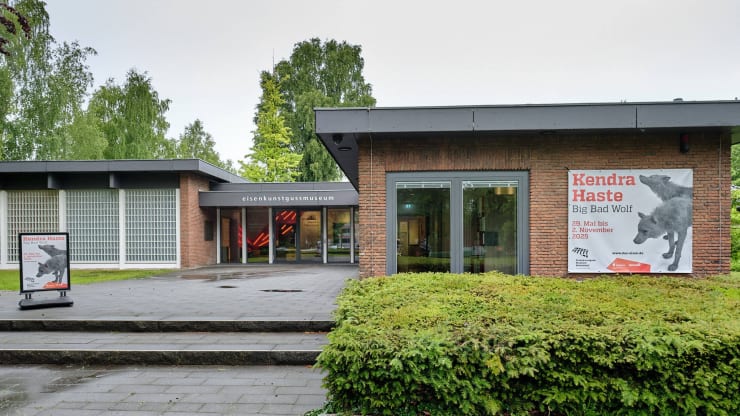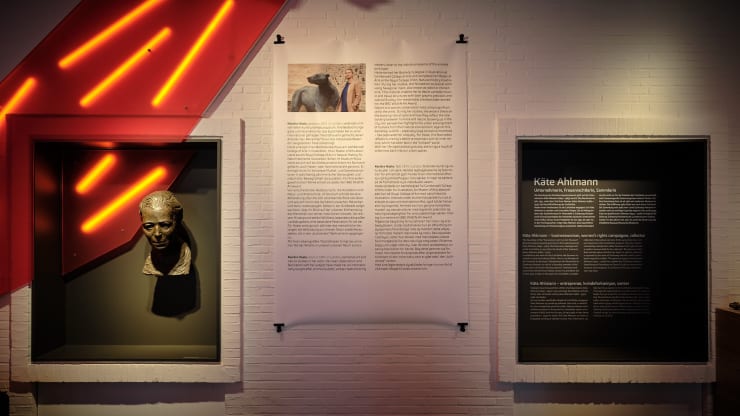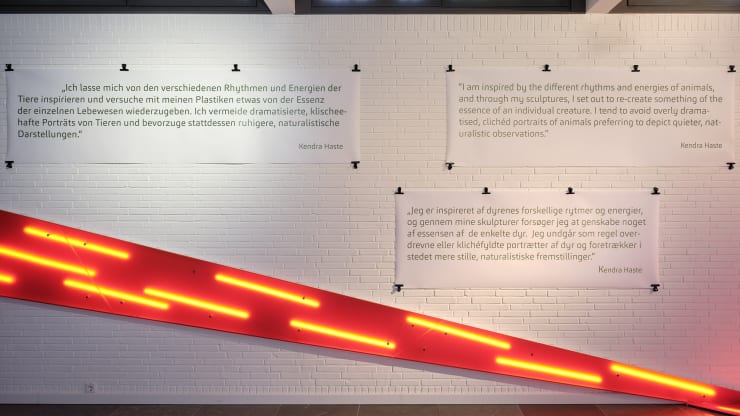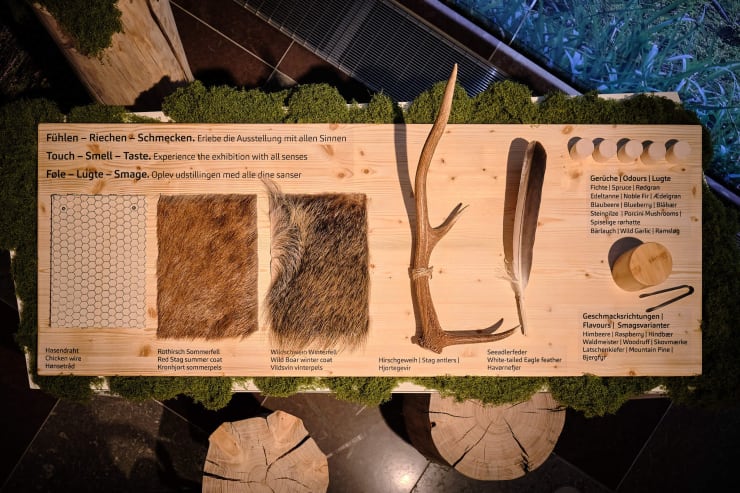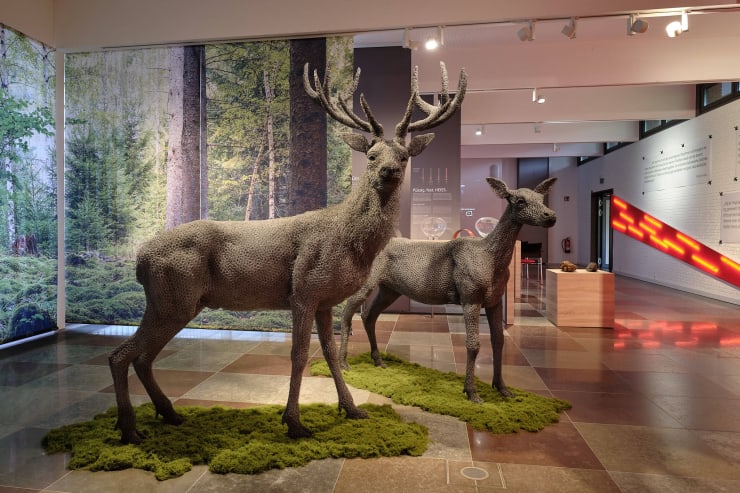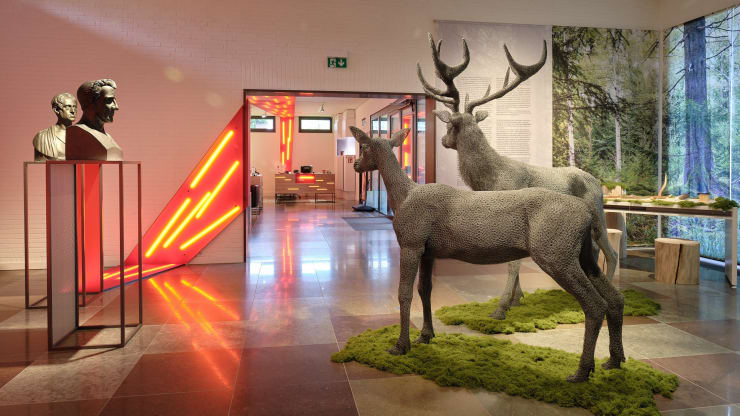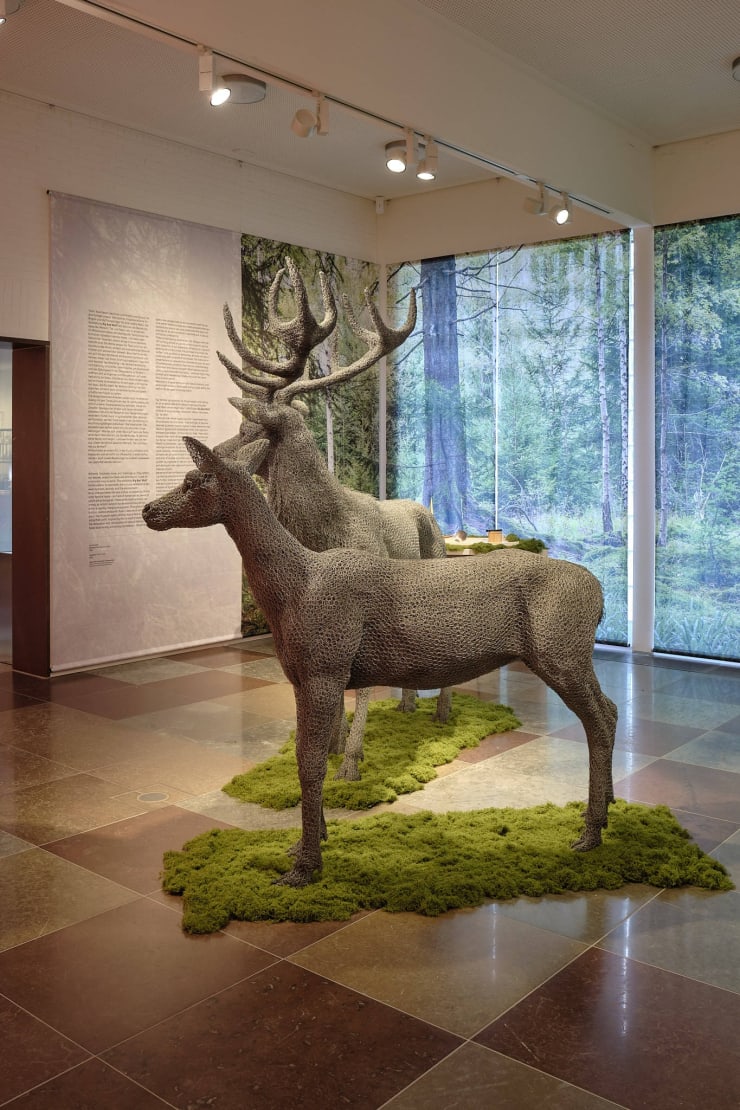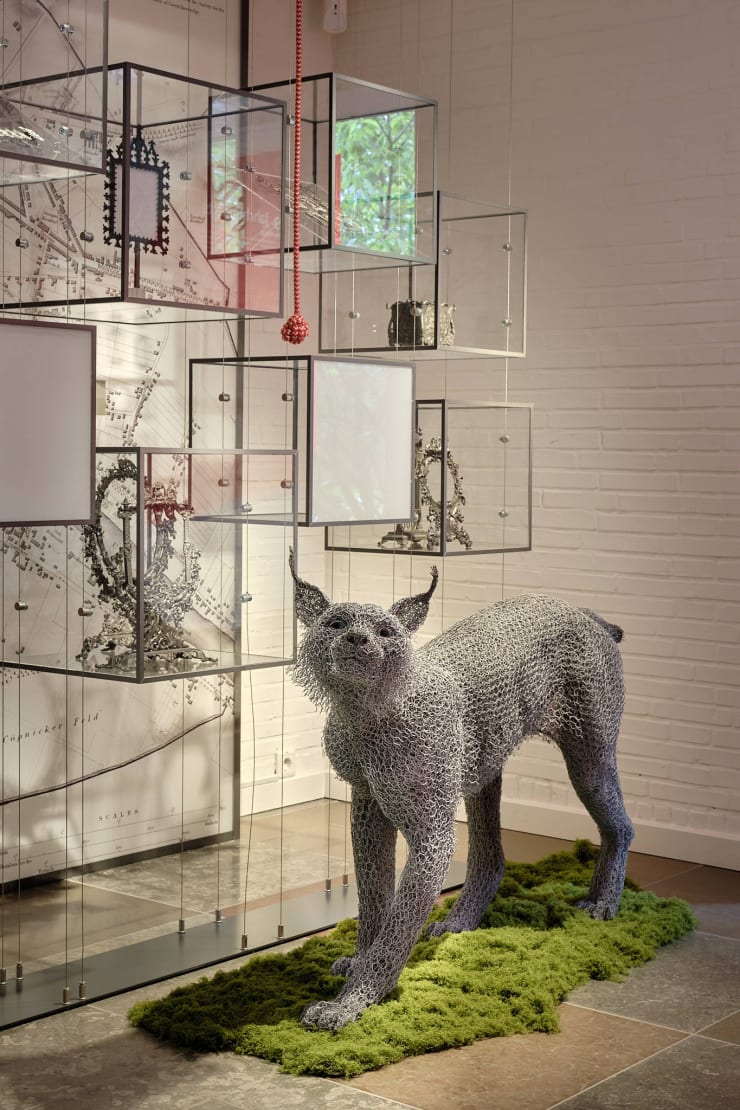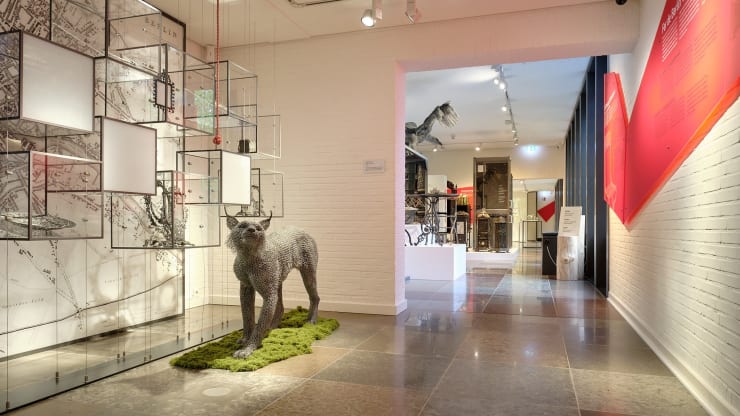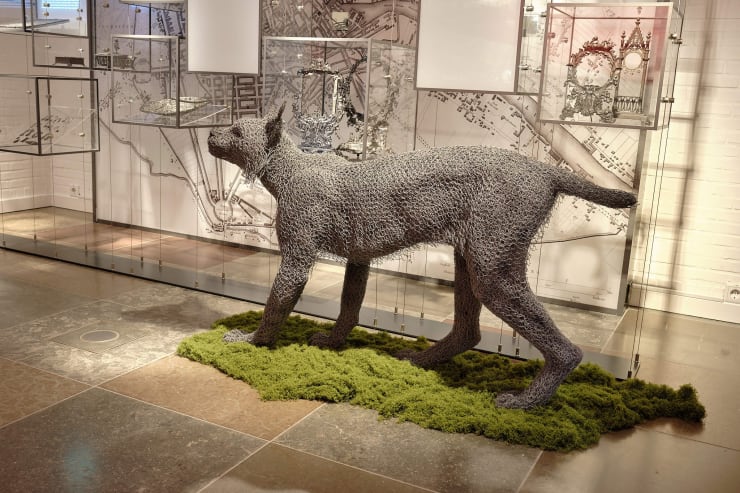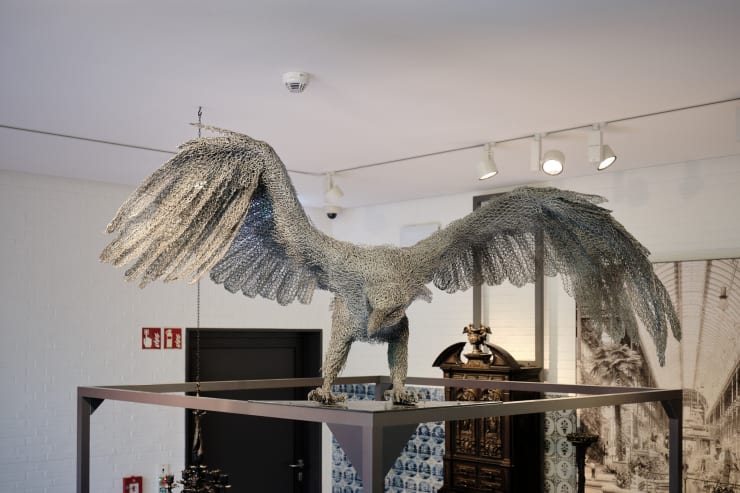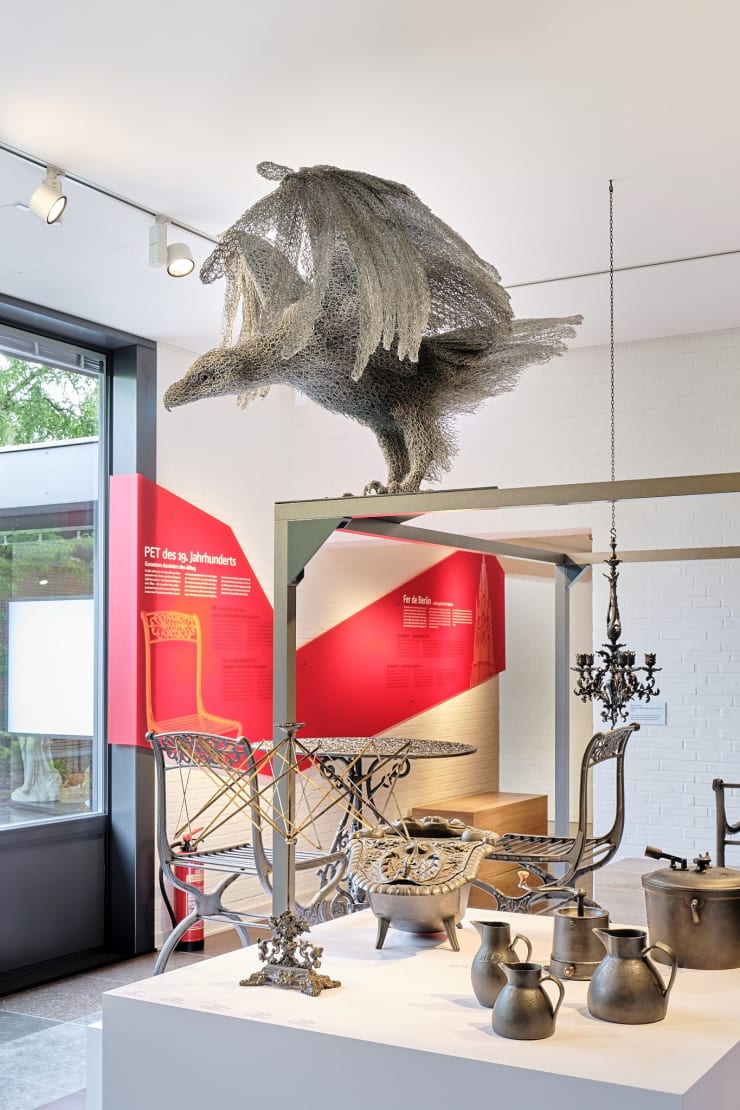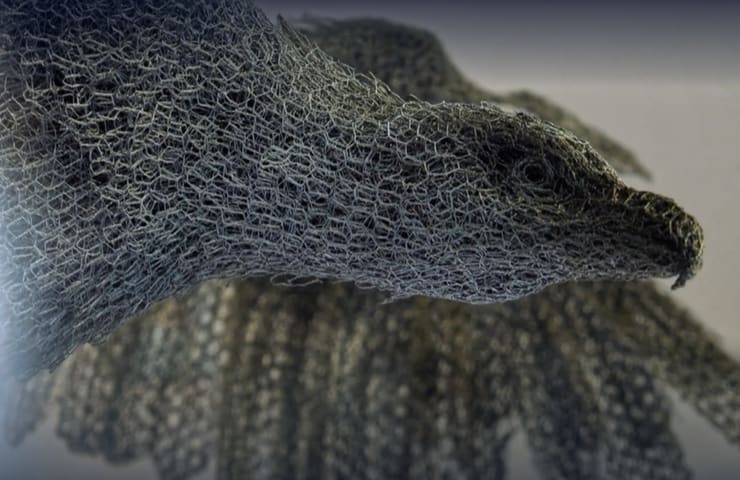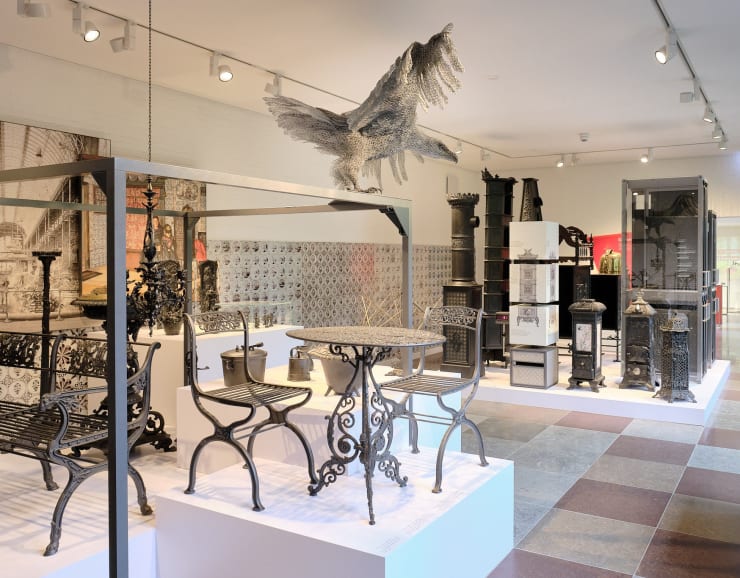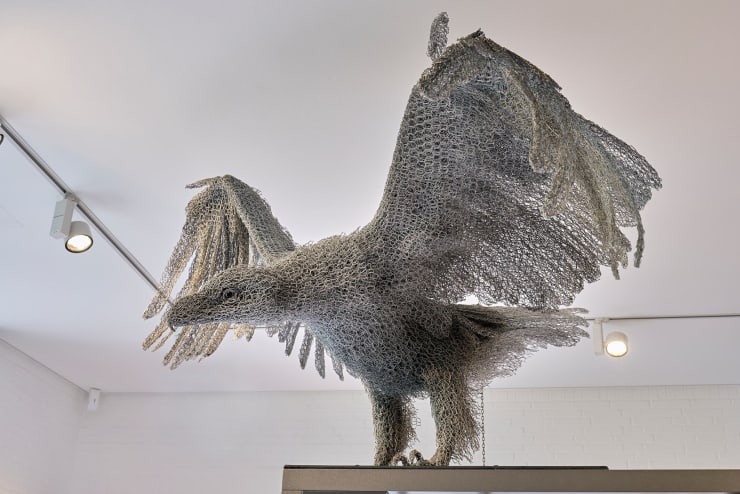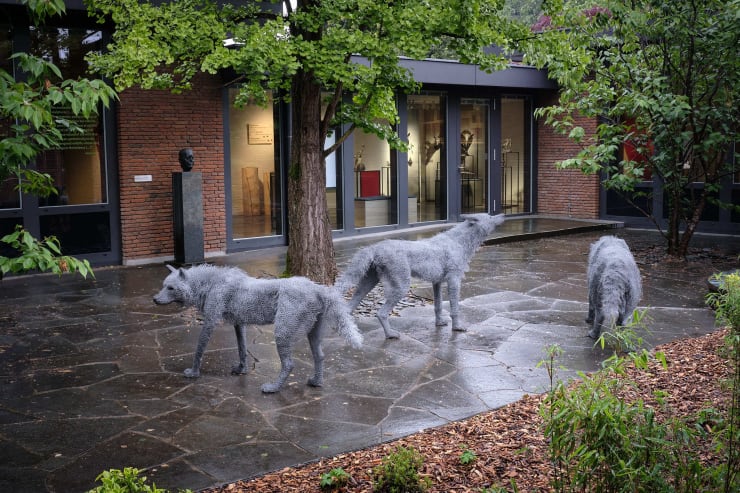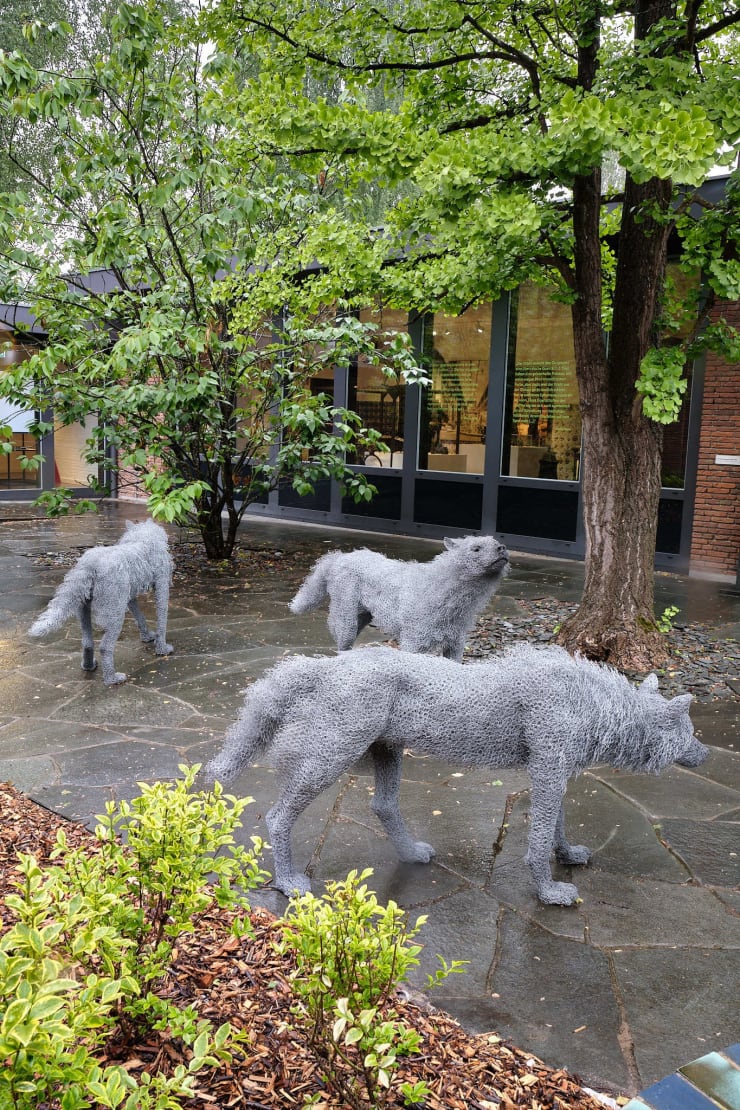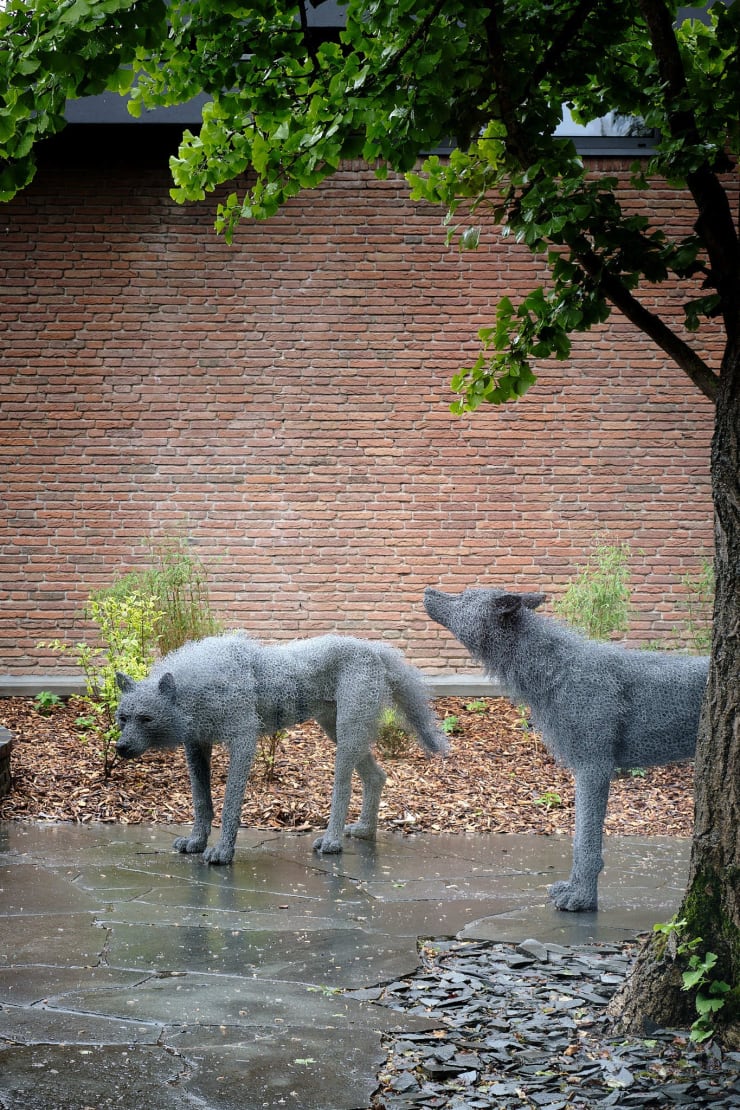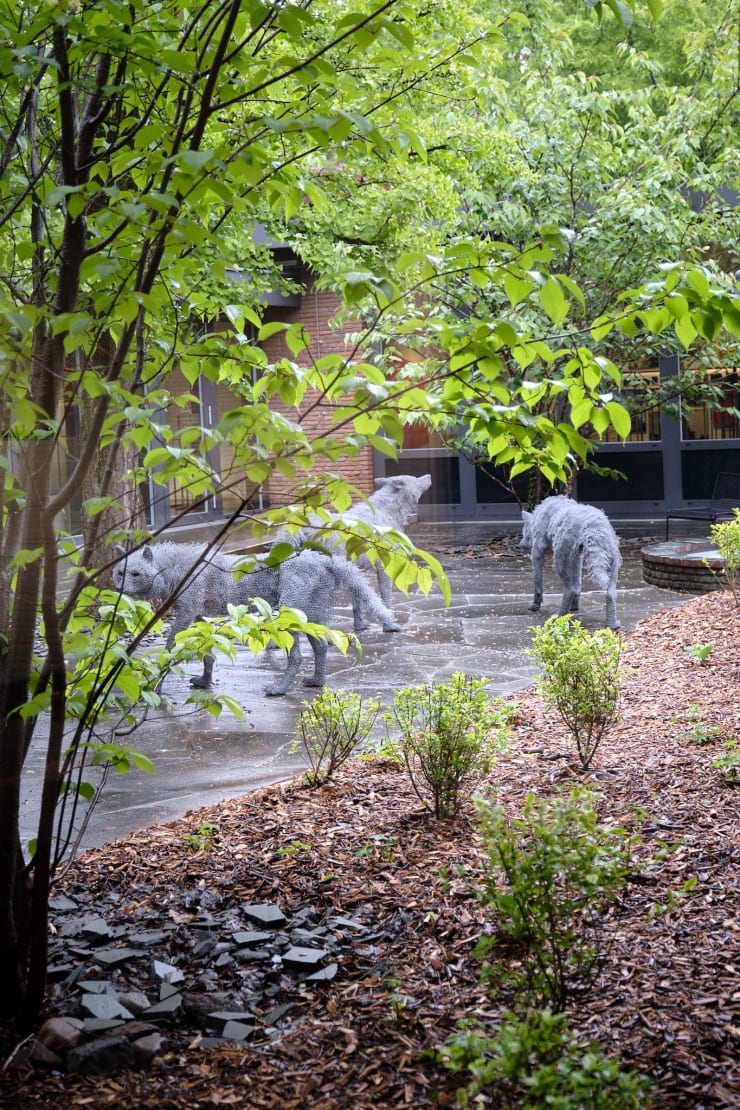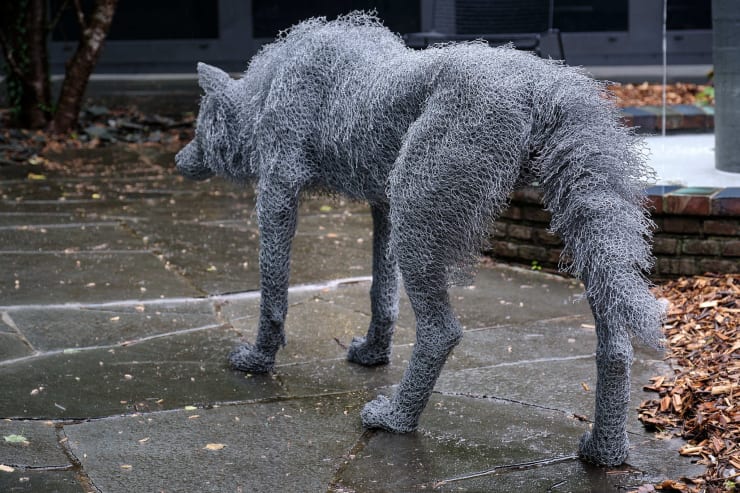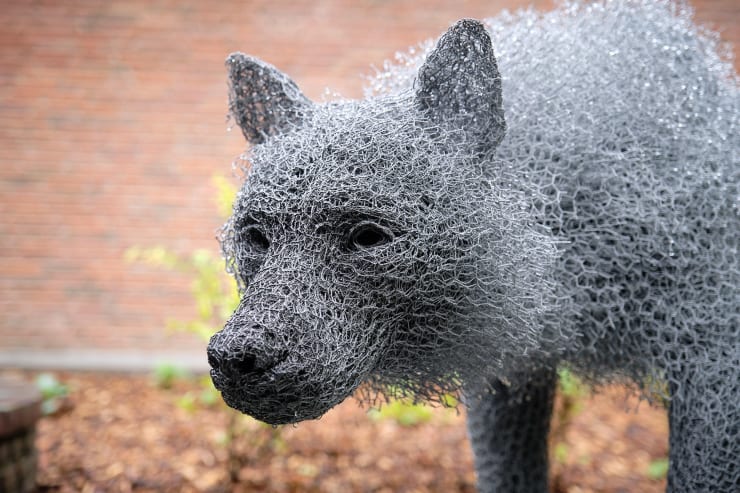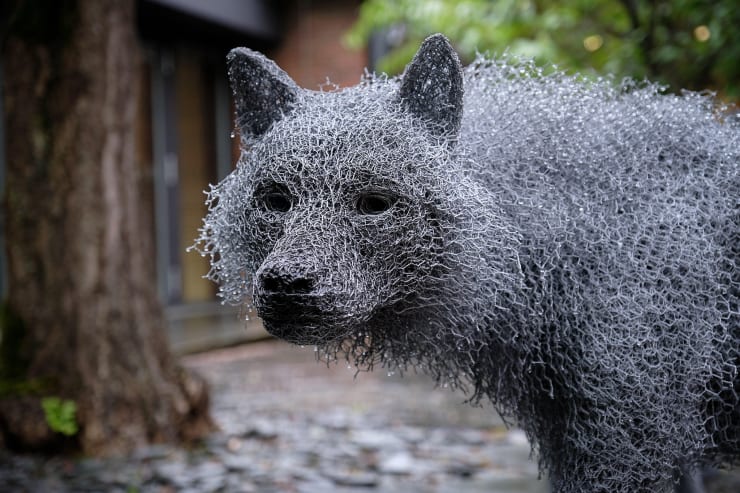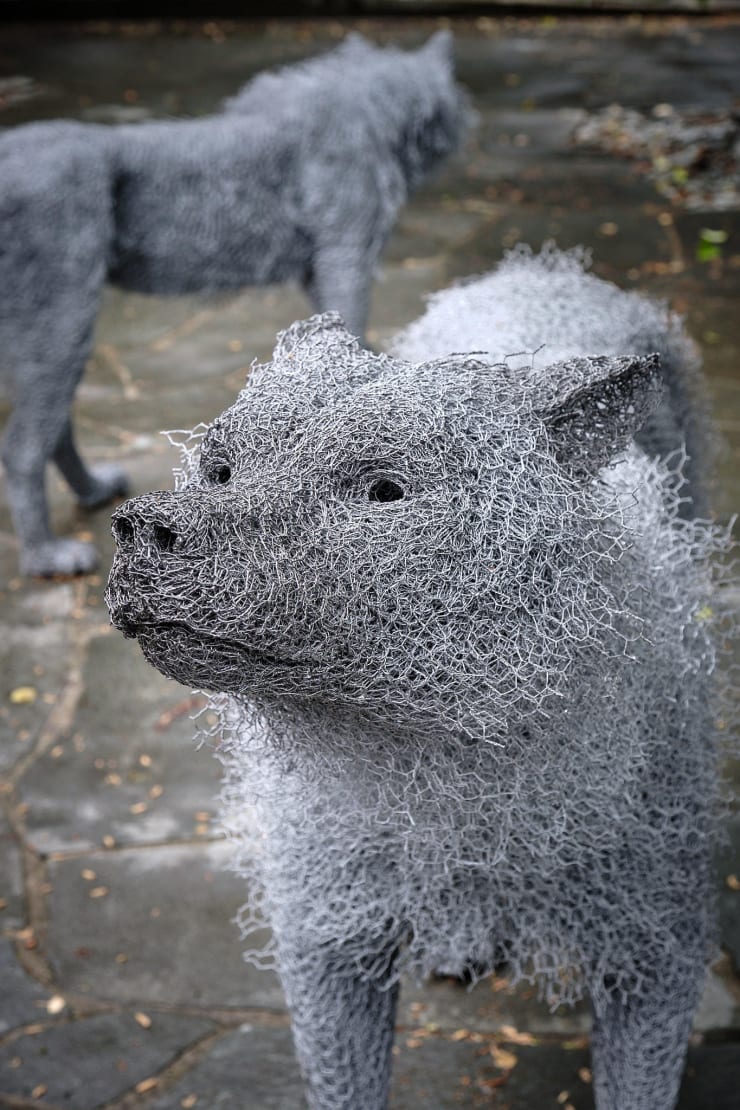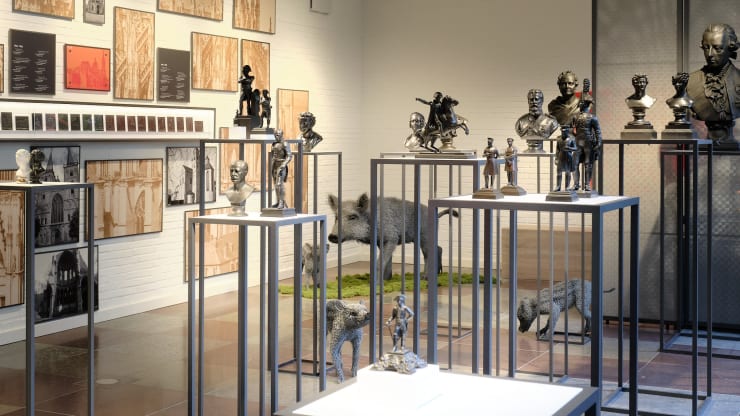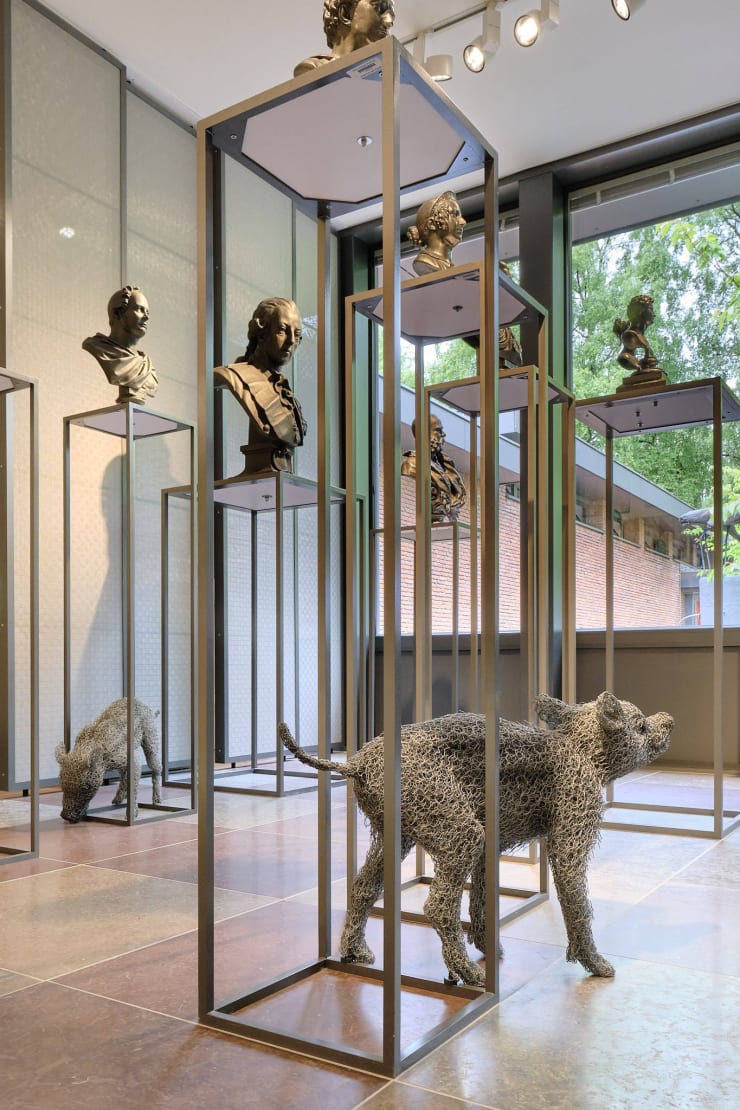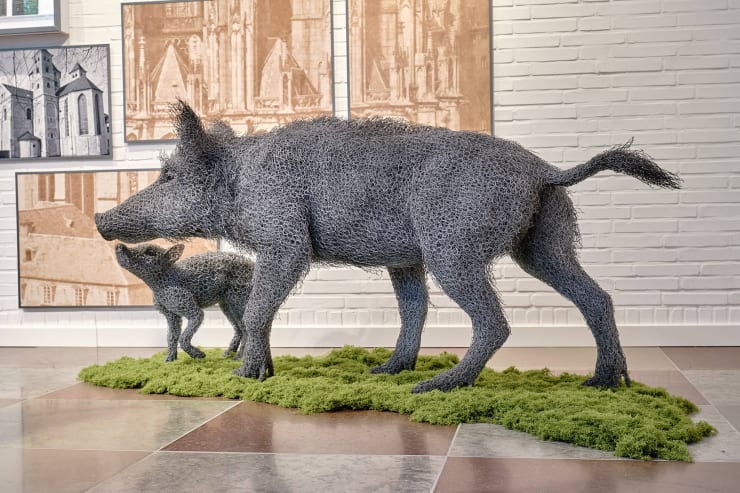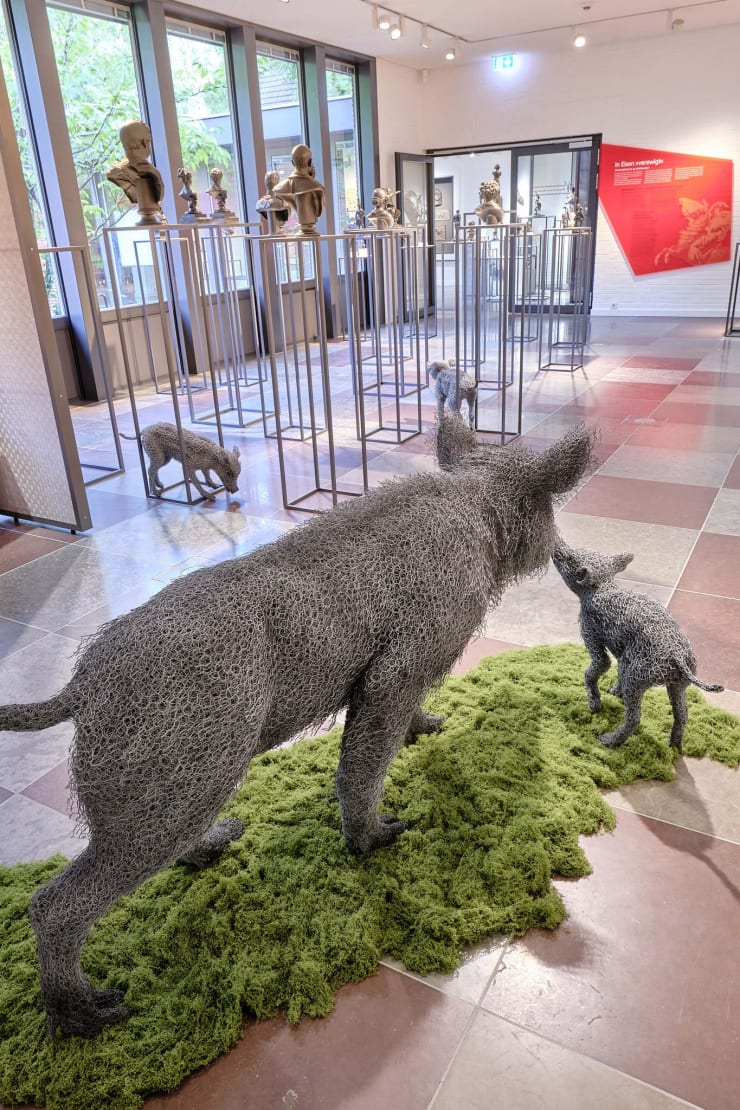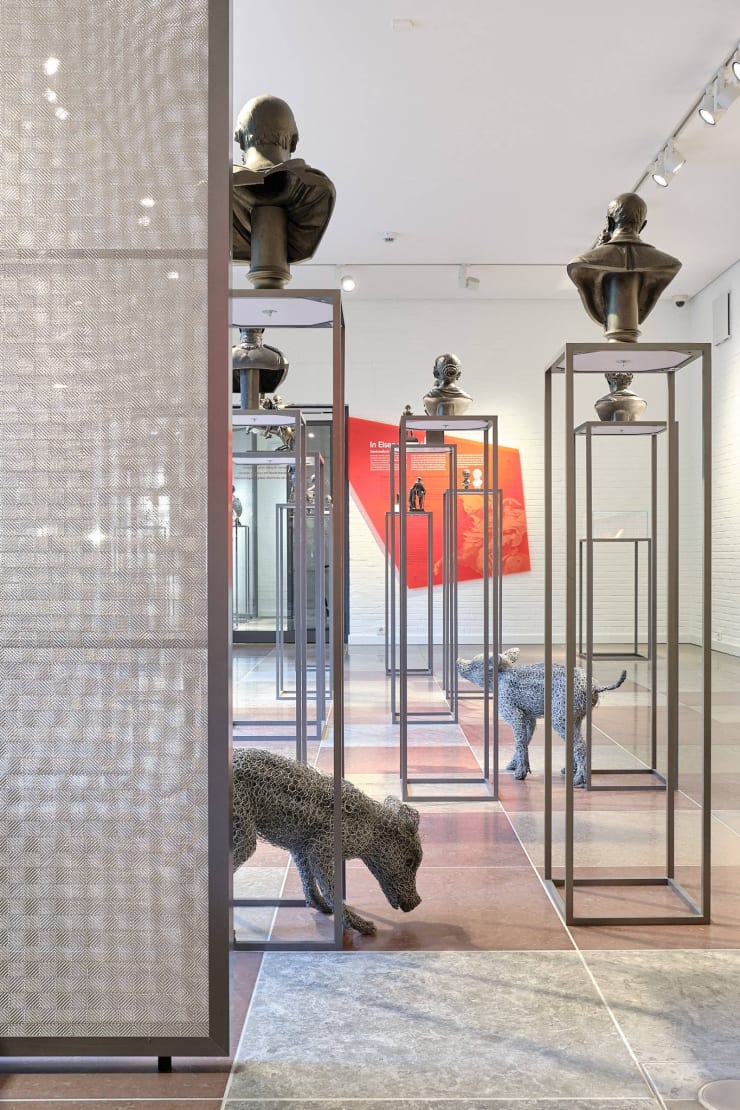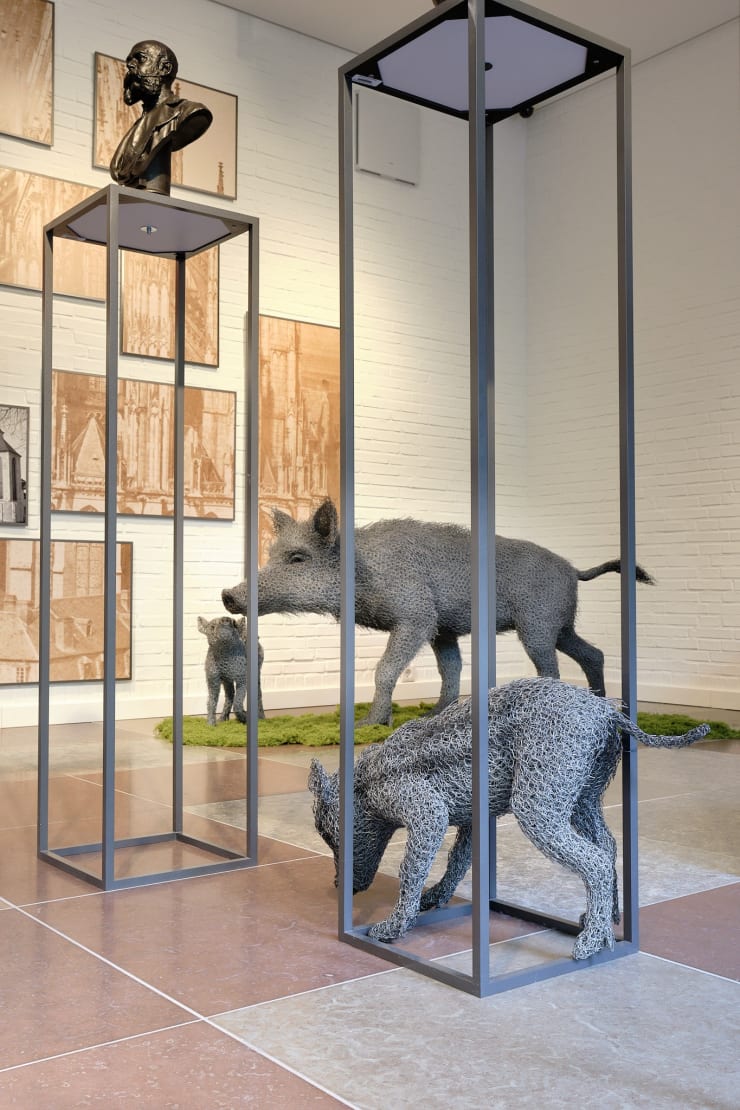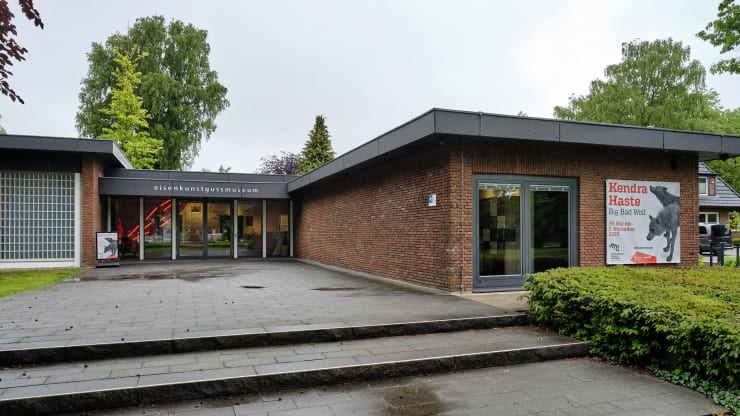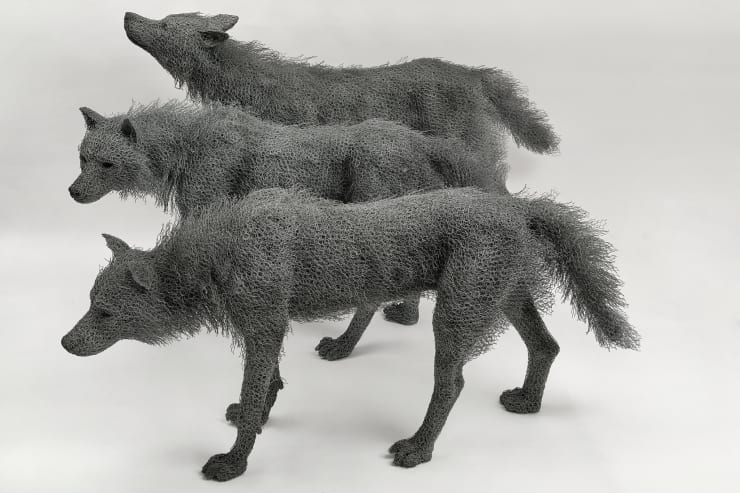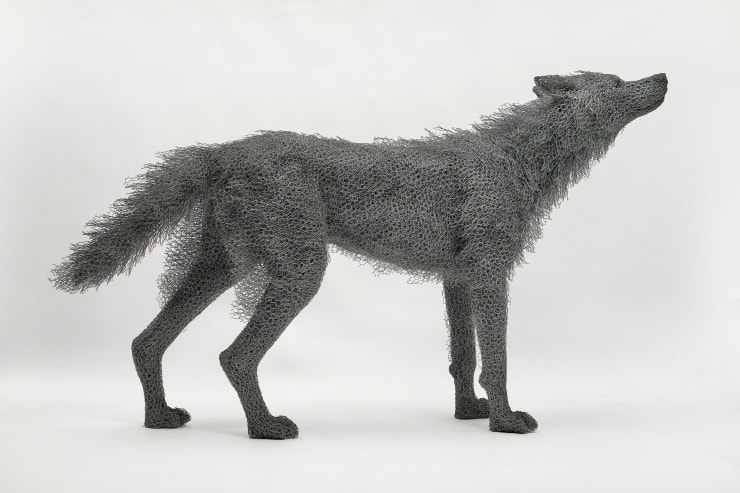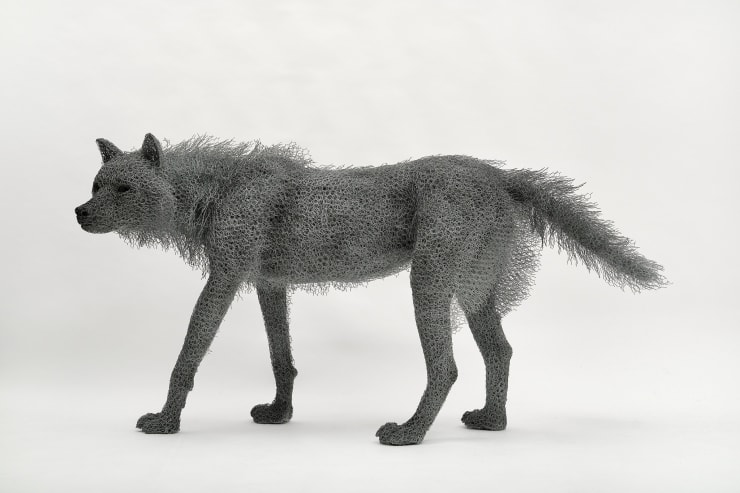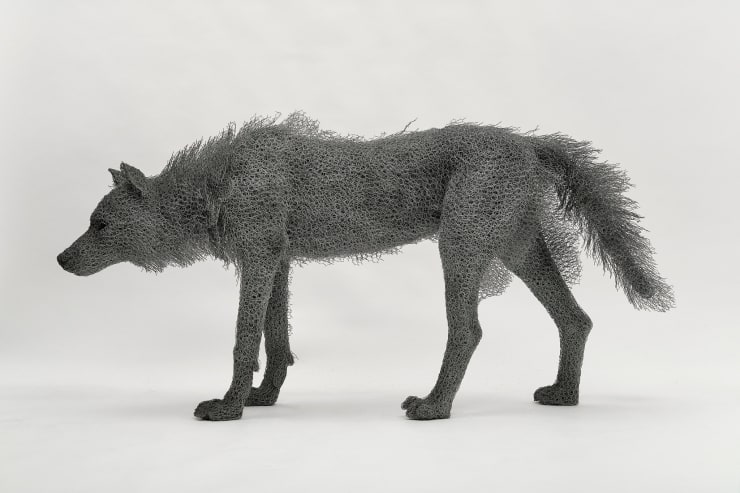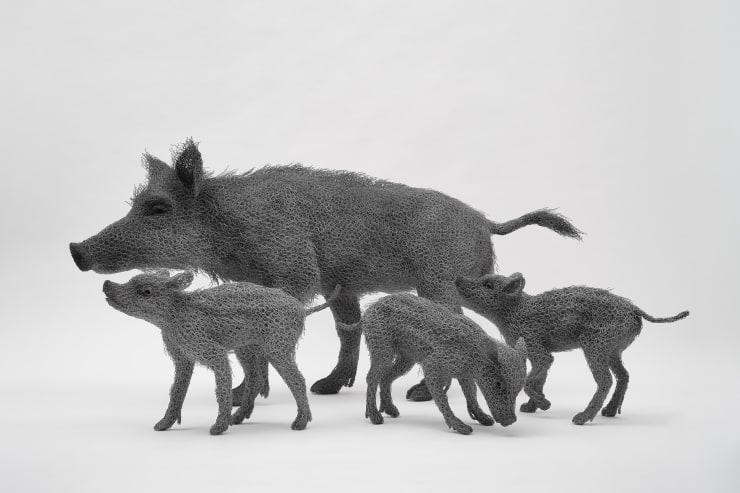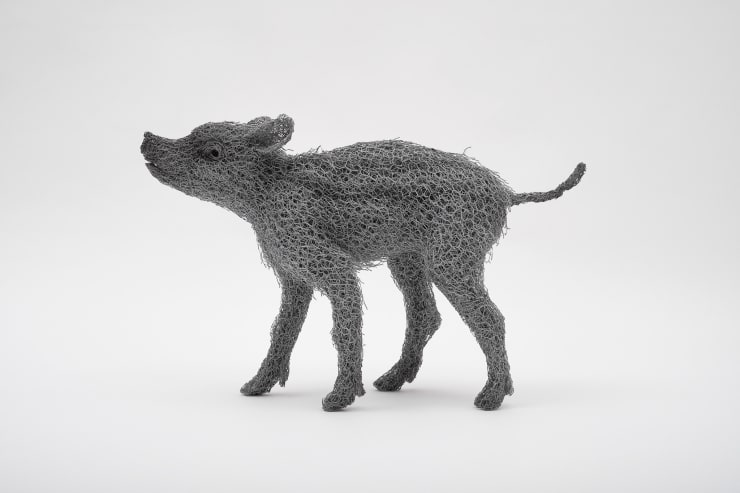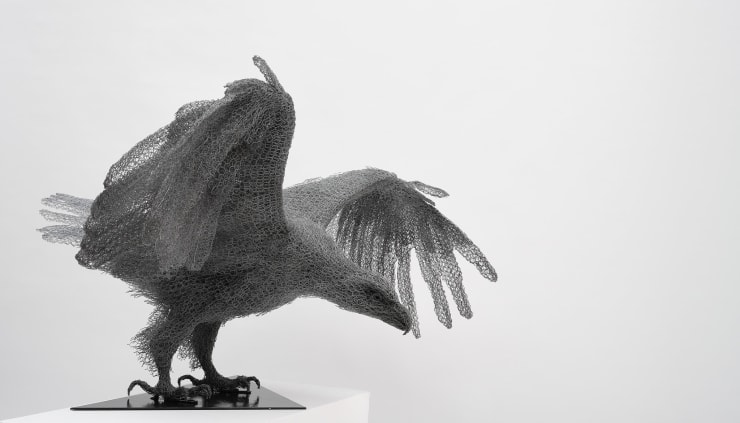Kendra Haste MRSS: Big Bad Wolf
-

-
Exhibition Installation
-
Sculpture
-
Artist Statement
The Big Bad Wolf exhibition has been an interesting and rewarding collaboration. I’m thrilled to have my work exhibited at the Ornamental Cast Iron Museum, especially in dialogue with its remarkable permanent collection of historically significant and beautifully crafted cast iron objects.The material I use—steel wire mesh—is an iron alloy, yet it starkly contrasts the weighty cast iron pieces in the collection. This contrast, I hope, emphasises the qualities of lightness, vitality, and animation that define my animal sculptures.The works in this exhibition depict native German wildlife. The title Big Bad Wolf invites viewers to consider how we coexist with wild animals, particularly with apex predators, which often provoke controversy. As the title suggests, how do we perceive wolves? Are they to be feared or essential players in maintaining a balanced and healthy ecosystem?Materiality plays a crucial conceptual role in the exhibition. The wolves' sharp, bristling texture discourages touch, establishing a sense of boundary and space, echoing the instinctive distance wild animals maintain from humans. At the same time, the mesh’s delicacy and semi-transparency evoke the vulnerability and fragility of wildlife in the modern world.Each sculpture begins with a welded steel frame, over which I build a rough skeletal structure. From there, I meticulously sew the mesh—layer by layer—forming musculature, skin, fur and hair. Unlike solid cast metal, the open weave of the mesh suggests the structure beneath, lending the work an organic, living quality. Though labour-intensive, the medium is incredibly expressive, allowing for nuanced surface textures and tonal variation that communicate strength and sensitivity.I hope viewers connect with the work not only visually but also through its themes, materials, and subject matter. I’ve long been captivated by animals' anatomy, behaviour, and presence. My goal is to capture their essence, not as idealised symbols, but as unique, sentient beings with their own agency.As visitors move through the exhibition, I hope they are prompted to reflect on wildlife's right to exist on their own terms and consider how we, as humans, might redefine our relationship with nature. These questions have never been more urgent in an age of ecological crisis, mass extinction, and declining biodiversity. -
Introduction by Dr Thorsten Sadowsky
Thorsten is Scientific Executive Director of the Schleswig-Holstein State Museums Foundation and Director of the Museum of Art and Cultural History Gottorf CastleKendra Haste, born in London in 1971, combines art and nature studies in her work. Her keen observation and fascination with her subject have made her an internationally sought-after animal sculptor, whose creations bring viewers closer to the individual essence of the animals portrayed. Her work Baboon earned her the BBC Wildlife Artist Award. Most recently, several of her works were on display at the Homo Faber Biennale in Venice, where she was a guest artist in 2024. We are delighted to be able to present the British artist's work in a museum exhibition in Germany for the first time.
During her studies, Kendra Haste already focused on sculptural work using hexagonal mesh, also known as rabbit or chicken wire. The drawing of the animal, which is an elementary component of Haste's artistic work, is transferred into three-dimensional space with the help of the linear quality of this material. Although the wire mesh is an industrially manufactured product, its hexagonal cut-outs are reminiscent of the surface structure of skin. This gives the works an additional organic component, which the artist plays with. By condensing many individual layers of the wire mesh, the illusion of complex muscle and tissue structures is created and the movements and characteristics of the respective animal are captured. The direct and intensive study of the animal's appearance is essential for this.
The artist, who grew up in London, had no contact with nature and wildlife for a long time. She sees this as the reason for her later fascination and enthusiasm for wild animals and their depiction, which continues to this day. Her aim is to reflect the essence of the individual animal and not to create a symbolic projection surface or drift into the esoteric. Her works reflect our relationship to animals and the environment. Nature conservation and species protection are of crucial importance to Kendra Haste.
For the Big Bad Wolf exhibition, the artist has created ten life-size animal portraits - depictions of native animal species, some of which are endangered. The artist's animal portraits invite us to explore our relationship with these animals. They challenge us to take a closer look - not only at art, but also at the world that surrounds us. The title of the exhibition plays with age-old stereotypes and fears that have become ingrained in our minds about certain animal species. From the Aesopian fables and their diverse reception history, we have learnt that the fox is clever and cunning, the lion is powerful and proud, the beaver is industrious, the lamb is defenceless and the wolf is evil and deceitful... It is difficult to argue against the attribution of human characteristics and the discrimination of animals has not been critically questioned for a long time.
Kendra Haste's contemporary works are also in direct dialogue with the 19th century animal sculptures in the permanent exhibition of the Ornamental Cast Iron Museum. Today, in an age of ecological crises and new ethical debates about our treatment of animals, the reception of animal representations has changed: Whereas in earlier times the focus was more on their symbolic or decorative function, animals are now being depicted as sentient individuals. The historical depictions of animals are thus scrutinized anew against a background of changing attitudes: How has our view of animals and nature changed? What can the works of the 19th century still tell us today - and to what extent do they challenge us to rethink the relationship between humans, animals and nature?
The exhibition is the result of an intensive examination of the content, but also the product of an inspiring collaboration. My special thanks go to Kendra Haste, whose contribution was invaluable. For over a year and a half great sensitivity and inexhaustible creativity have been invested into the ten new animal sculptures that form the foundation of this exhibition and now enliven the Ornamental Cast Iron Museum as wire-woven guests. Our collaboration was and still is characterized by mutual trust, openness and a lively exchange. I would also like to take this opportunity to thank Patrick Davies (Patrick Davies Contemporary Art) for his commitment and highly professional support in preparing the exhibition. I would also like to thank Bill Mudge and Daniel Redding for producing the delightful accompanying film.
I would especially like to thank the colleagues involved for their great commitment to the realization of this important exhibition: Ulrike Biedenbänder for the careful curatorial planning and realisation of the exhibition, Thekla Kock for the exciting mediation stations, Ann Henningsen, Gunar Großmann and the entire installation team for their good ideas and excellent work, Jürgen Schüller and Dorothea Berg for the fine graphic realization, Karen Nissen for her active administrative support with the loans, Kirk Bock and Jörgen Andersen for their support with everything that had to be done around the house. Museum work is always a team effort and so my sincere thanks are also extended to those who are not mentioned here by name.
-
Essay by exhibition curator Ulrike Biedenbänder
Ulrike is curator of the exhibition and Director of the Ornamental Cast Iron Museum BüdelsdorfAnimals in art - a reflection of a changing understanding of nature
‘We must learn to understand nature from within, not ourselves from nature.’– Arthur Schopenhauer, 1788 –1860
Animals fascinate, touch and challenge us. They are a mirror of our desires, a projection screen for our fears and a beacon of hope for an intact natural world. It is therefore hardly surprising that the depiction of animals is almost as old as human history itself and has accompanied mankind since its cultural beginnings. Yet the depiction of animals in art is far more than mere representation - it is an expression of the respective view of the world and mankind. Over the centuries, the artistic depiction of animals has not only reflected aesthetic developments, but also the changing relationship between man and nature. From the symbolic carrier to the scientifically observed object to the independent and dignified creature - the role of the animal in art is a key to the cultural understanding of nature. History shows us how man has always taken a stand in his view of nature. He finds different forms of expression to process his fascination with these creatures on the one hand and to distance himself from them on the other. The animals are ascribed a variety of roles: Friend and foe, prey and hunter, mythical creature and creature of nature, hell beast and sacred animal, alter ego and totem animal. Different forms of expression reflect the changing appreciation and significance of animal depictions throughout history, always depending on religion and the spirit of the times. At the same time, they document the way in which mankind has localised itself in nature and in relation to animals.
The animal as a symbol - pre-modernism, romanticism and symbolism
‘The animal is also a mirror of the soul - wild, gentle or cunning, depending on what man carries within him.’– Hildegard von Bingen, 1098–1179
The early depiction of animals is symbolically charged and has a ritual or magical background. Animals are not seen as independent beings, but serve as a mirror of human ideas and values. Characteristic features of certain animals that make them superior to humans, such as strength and speed, are categorised as divine powers. The depiction makes these divine qualities visible by linking them to the animal archetype. In the art of the ancient civilisations of Egypt and Mesopotamia, figures of gods in turn bear the characteristics of certain animals with supernatural powers. For example, the Egyptian god Horus, with his falcon-like head, embodies the strength, speed and vision of the bird of prey. Similarly, the Mesopotamian deity Lamassu is often depicted with the body of a bull, the wings of an eagle and a human head - a symbolism that combines strength, divine majesty and wisdom. In both cultures, the depiction of animals is thus not only understood as a decorative element, but also fulfils a deeper symbolic function: it serves to visualise divine qualities and demonstrates supernatural power in a vivid way. Ancient Greek art also follows on from this pictorial tradition, but increasingly depicts deities in human form, while animals are placed alongside them as companions whose supposed qualities are associated with them: Zeus is associated with the eagle - a symbol of dominion and power - while Athena is accompanied by the owl, the symbol of wisdom. In the Western tradition, the animal motif thus became a decorative secondary theme, but experienced its first high point in another respect: for the first time, artists depicted animals true to nature. The image of nature in antiquity thus moved clearly between mythological thinking and the beginnings of rational observation of nature. However, man always saw himself as part of the fabric of nature. This changed in the Middle Ages. In the Christian worldview, man is above all other earthly creatures. Nature is the bearer of a higher truth, created by God, whose certainties lie in religion and not in the observation of nature. Accordingly, depictions of animals in the Middle Ages were not intended as a realistic representation of characteristics based on the observation of nature. Rather, they served the moral, symbolic and religious interpretation of the world. Fantastic animal creatures are depicted in the same way as real animals. The use of animal depictions is particularly diverse as a decorative element. Their abundant use in book illumination and monastery architecture even led ascetic church teachers such as Bernhard von Clairvaux (around 1090-1153) to criticise them as a dangerous worldly distraction.In the 19th century, Romantic and Symbolist artists once again turned their full attention to depicting animals in their symbolic meaning, while many of their colleagues from other artistic movements took a different path - more on this later. The Romantics saw animals as part of a mysterious, animated nature that was beyond the rational grasp of humans. This idea goes hand in hand with a contemplative veneration of nature and a glorification of the animal. The stag, for example, becomes a symbol of purity and natural mysticism, the epitome of solitude and sublimity. The symbolists used animals as spiritual expressions of inner states, emotional conflicts and cultural archetypes. Fantastic and real animals and animal creatures are depicted in equal measure, often in a dreamlike or even threatening manner. The artists are more interested in mysticism than in anatomically correct reproduction.Animals as Objects, Renaissance, Realism and Science
Science has the power to make us masters and owners of nature.’ - René Descartes, 1596-1650
The Renaissance era marked a return to the interest in nature and knowledge of antiquity. Scholars such as Leonardo da Vinci studied nature and recorded their observations directly, realistically and anatomically correct. Accompanied by the intellectual current of humanism, the 16th century saw the emergence of cabinets of art and curiosities, in which everything that represented the diversity of the world was collected. Animals continued to retain their symbolic significance, but also became an essential part of the study of nature. Animal specimens and bones were collected and drawings were made which, thanks to the invention of printing, were not only passed on in model books but also distributed as illustrations in encyclopaedic and zoological books. One of the most outstanding and still best-known examples of animal illustrations from this period is Albrecht Dürer's ‘Field Hare’ from 1502.Despite outstanding examples, the depiction of animals was not yet an independent pictorial theme at this time. It was not until the 17th century that the animal image attained such a special status that it developed into its own genre - the animal piece. A wealthy, self-confident bourgeoisie developed in the Netherlands, representing a new, secularised world view. The accompanying secularisation of art contributed significantly to the emancipation of previously religiously dominated pictorial themes. In parallel to landscape, genre and still life painting, the animal piece also developed as an independent pictorial form - and permanently anchored the animal as the main motif in the world of autonomous art genres. The animals depicted represented different areas of life and were either everyday, economically significant or symbolically charged. In most cases, they provide a link between the observation of nature and cultural interpretation. The painter Paulus Potter devoted himself in particular to the depiction of cows in idyllic rural scenes. Frans Snyder's hunting still lifes characterise the genre with their dramatic, luxurious and realistic depiction of dead game, dogs, birds and hunting accessories.
‘Anything that is against nature will not endure in the long run.’ - Charles Darwin, 1809-1882
The depiction of animals in the 19th century is multi-layered and reflects the tensions of a time of profound upheaval - characterised by industrial progress, scientific discoveries and growing mechanisation. Driven by a belief in progress and reason, a new relationship to the natural world developed: no longer as part of a divine cosmos or as an animated counterpart, but increasingly as a storehouse of raw materials to be exploited. At the centre of this is man's self-image as the designer, master and conqueror of nature. However, this belief in progress was not without its opponents, who emphasised the connection between man and nature. The concept of man as the ‘crown of creation’, to whom the world submits, was radically realised in the 19th century on the one hand, and profoundly questioned for the first time on the other. Charles Darwin's theory of evolution made a decisive contribution to this ambivalence: It removes man from the centre of creation and makes him a part of the natural process of life. This results in a wide variety of approaches to the depiction of animals. The two movements of Romanticism and Symbolism have already been mentioned above. In contrast, Realist artists captured animals with great anatomical precision as part of rural life, the world of work or nature and hunting. Colonial expansion also brought exotic animals into focus. Zoological gardens were established and became a popular destination for excursions. Various zoological animal studies by Impressionists such as Max Slevogt and Max Liebermann are known, which on the one hand reflect the atmosphere of the zoos and on the other demonstrate their passion for observing nature. In both movements, the depictions of animals are an expression of observation and documentation, but remain objective. Here, animals are farm animals, hunting animals or objects of study and as such are functionalised and subordinated to humans.
Animals as images of the soul - Modernism and Expressionism
'The spectacle of nature lives in the hearts of men, to see it one must feel it.’ - Jean-Jacques Rousseau, 1712-1778
Since the 1960s, animals in art have increasingly become part of an ethical, political and ecological discourse. Particularly with artists such as Joseph Beuys, the animal no longer stands alone, but becomes part of a comprehensive way of thinking about humans, nature and society. In performances such as ‘I Like America and America Likes Me’, in which Beuys lived with a coyote for three days, the animal becomes the symbolic antagonist of Western civilisation - a creature that promises healing and connection with the primordial. From the 1990s and increasingly in the early 21st century, the so-called ‘animal turn’ took place. Artists began to take animals seriously as independent, sentient actors.
Today, in the age of the Anthropocene, the suffering of animals, species extinction and environmental destruction are increasingly becoming the focus of art. In contemporary art, animals are therefore often no longer just depicted, but represent themselves - as living beings with rights, as co-actors in the ecological network. The modern understanding of nature is characterised by responsibility, solidarity and critical reflection on human supremacy.
Through the centuries to the present day
‘Every being is infinitely valuable as such, simply because it is.’ - Nicholas of Cusa, 1410-1464
The depiction of animals in art is an indicator of the change in our understanding of nature. From symbolic projection to scientific observation and ethical co-responsibility: art shows how the relationship between humans and animals - and thus with nature - is changing and developing. In this way, art not only documents aesthetic perspectives on animals, but also becomes a mirror of philosophical and ethical questions: How do we define nature? What does it mean to be human in the face of nature?
At a time when ecological crises are increasingly preoccupying us, the depiction of animals is also moving into a different focus: do we still see animals as objects - or finally as fellow beings? The artistic exploration of animals thus remains a living expression of our changing understanding of nature - and an invitation to constantly rethink the relationship between humans and animals.
-
Film - Drawing with Wire
Made by Bill mudge and Daniel ReddingCommissioned by the Ornamental Cast Iron Museum in Büdelsdorf, Germany, to accompany Kendra Haste’s solo exhibition ‘Big Bad Wolf’, running from May to November 2025.
In the film, Kendra reflects on her artistic practice, the themes of rewilding and conservation, and the process behind creating eleven new sculptures for her first solo museum exhibition.
-

Kendra in Conversation with Matt Lippiatt
Matt is a freelance writer and artistBig Bad Wolf
Matt Lippiatt: This exhibition presents a new group of your sculptures, commissioned by the Ornamental Cast Iron Museum and displayed throughout the museum. How did the project come about?Kendra Haste: The museum approached me through the Society of British Sculptors. My animal subjects and my use of material appealed to them because the wire I use is made from mild steel, a derivative of iron ore, so there’s a direct connection with the cast iron works in the museum collection.ML: What are the themes of this new body of work?KH: It’s about exploring our attitude towards animals, and specifically the subjects of rewilding, conservation and biodiversity. The title of the exhibition is Big Bad Wolf. I think wolves generally get a bad press, going back to the Grimm’s fairy tales and fables of old, and I want to question that idea of the “big bad wolf”. In Germany, wolves have been reintroduced – in fact, they have naturally migrated over the border from Poland and have established a growing population. That’s causing problems for sheep farmers, and in the press the issue has become very politicised unfortunately. There is some opposition to the idea of rewilding in general, and many would like to see the wolves out of Germany, which is a real pity. So, the question of the “big bad wolf” is still current: is the wolf a threat to us, or do they help us in terms of restoring the function of predation in the ecosystem, self-regulating landscapes and increasing biodiversity?ML: The animal species you represent in this exhibition are local to Germany. How do you see the relationship between these sculptures and this location, and the museum itself as a frame for the work?KH: In this exhibition my work will be an intervention alongside the museum’s displays of decorative iron work. There are links to animals throughout the museum, with animal forms appearing often as decorative motifs. There is also a nineteenth-century hunting room, with animal heads presented as trophy heads on the wall. The museum’s collection is reflective of our changing relationship with animals and nature, through the ages.All of my sculptures represent the animals at life size, and scale is very important in this exhibition. Architecturally the museum is a series of quite confined intimate rooms, and there are a lot of small deer bronzes in the collection, so having my life size sculptures of red deer in this space draws attention to their scale. They are surprisingly large animals, physically powerful and requiring space.ML: Will all of your sculptures be inside the museum?KH: Most of my sculptures will be inside the display rooms, but the wolf sculptures will be outside in the courtyard. The placement of the sculptures creates a sense of movement because the animals are positioned as if they are all walking around in the same direction, like a parade through the museum. Visitors will be able to walk amongst the sculptures, they won’t be kept at a distance. The museum wants the visitors to be confronted with the animals, to give a sense of their physical presence and power. It is as if we are giving the animals dominion over the museum.ML: Like during the Covid lockdowns, when wild animals began to venture into urban areas that would usually be crowded with people.KH: That was extraordinary, wasn’t it? Deer roaming empty roads.ML: Animals are a consistent theme in your work, and you’ve also consistently used wire mesh as a sculptural material. What is the relationship between these two aspects of your practice?KH: I started using mesh when I was in my final year at art college – thirty years ago! Animals have always held a deep fascination with me. I was doing a lot of drawings at London Zoo, so I think subliminally the wire cages that I was drawing the animals through may have influenced me. The choice to work with mesh for as long as I have is an aesthetic decision, but the fact that it’s also a material associated with caging, for sure, has a bearing on the subject of wild animals, captivity, and our relationship with the “wild” world.ML: You study the anatomy of the animals that you sculpt, and your sculptures have a level of anatomical accuracy that is unlike other more stylised and expressionistic representations in modern and contemporary art.KH: I love the scientific side of learning about anatomy. For my MA I studied natural history illustration at the Royal College of Art. That was wonderful, involving lots of time spent at the Natural History Museum with behind-the-scenes access to the collections there. We were encouraged to look really closely at form and all the internal mechanics of animals. Skeletons fascinate me, and locomotion, all that stuff. I also love all the early illustrations, the work of biologists, and that inspires my own work.
That said, I also try not to let anatomical accuracy overwhelm the process of creating sculptures. I will alter certain proportions slightly if it adds more of a sense of animation. I’m trying to convey something of the character of the animal, so there are a lot of decisions that I’ll make judging by eye rather than measuring for precise accuracy. It has to read right visually, with a spark of life. It’s great when a sculpture starts to create the sense that I’m sharing the studio with another being and it has its own presence and character.ML: Is it unusual for you to make a group of works like this for a single project?KH: Previously I have made a menagerie of animals for the Tower of London, which is on permanent display there. Those sculptures tell the story of the animals that were kept at the tower over the centuries. As with Big Bad Wolf, the Tower of London sculptures are reflective of our changing attitude towards animals.I really enjoy working on projects involving groups of works. As a professional artist I generally work to commission, so typically I’m making one piece at a time for clients. Sometimes bigger groups, but more often single pieces. Practically, it’s very difficult to set aside a year to develop a larger body of work, so when an opportunity like this comes along, it’s fantastic.ML: Your use of wire mesh as a sculptural material is very unusual. What is it about this material that you like?KH: I enjoy the linear aesthetic of wire, it simulates line drawing in three dimensions, the mesh is like cross-hatching, and it has a graphite quality in its form and colour. I find with other materials, cast bronze pieces of animals for example, there is something rather cold and dead. With the wire mesh the holes allow some visibility of the layering underneath the surface, creating a sense of the muscle and bone of the body, not just its surface shape. I also like that, by necessity, I am making the animals from the inside out.
In Big Bad Wolf, all the animals have a steel structure inside, apart from the boarlets. Those internal structures act as a core on top of which I make a crude skeleton, shoulder blades and so on. Then I build up the muscle groups, folding the wire mesh into shapes and sewing them onto the skeleton. It’s a really slow laborious process, very much rooted in anatomy.. The wire is also incredibly versatile in the effects it can create. For example, birds are very different from mammals and when the mesh is used to create plumage, it has the lightness of a feather, with light coming through, so it looks feasible that the bird could fly off. If the same form were cast in bronze, that effect wouldn’t be possible at all.ML: Could you say more about Big Bad Wolf’s theme of rewilding? In another interview you mentioned something called “the three C’s”.KH: The three C’s model is often used in rewilding approaches. The three C’s are: Core wilderness areas, Corridors, and Carnivores. The idea is that there should be core wilderness areas across Europe, left completely wild, with corridors linking those areas within countries and between countries, providing safe passage for animals. The third C, carnivores, are the missing species, necessary to keep the other animal populations healthily balanced. Landscapes have been transformed by successful rewilding projects, particularly in the USA, in places like the Yellowstone Park. Obviously, they have a lot more space there. This model has been adapted in more densely populated areas to Cores, Connectivity and Co-existence, with more of an emphasis on connection between people and nature and the beneficial need to co-exist and live alongside nature.In Europe, and here in the UK, there are huge challenges with farmland and dense populations rubbing up against wildlife. But if the areas are chosen well, rewilding absolutely can work, and we need to do it because biodiversity is at an absolute low and it’s our life support system. If it’s not addressed and we lose it, it’s gone. Food, water, climate control, medicine, everything depends on a healthy ecosystem.ML: How do these concerns inform the way you approach representing animals in your sculptures?KH: My intention is to depict animals in their own right and observed without too much of our human projections imposed onto them. Hopefully giving the animal subjects a sense of their own agency and power.When animals are the subject for your artwork, there’s always a fine line you tread- you want to avoid the work being over sentimental or cliched. The spikiness of the wire helps because people are less likely to want to touch or stroke the sculptures. Hopefully they are appreciated for their beauty and strong physicality, but the fact that they are spiky to touch is relevant to them being wild animals, not domesticated; they deserve respect and a little caution – you wouldn’t want to over handle the pieces. By capturing something of their instinctive nature and vigour, the audience will hopefully question and reflect on our response to wild animals.ML: Today, one of the challenges in art, and also in journalism and documentary film making, is how to honestly address the urgent problems in our relationship to the natural world, without falling into hopelessness.KH: Absolutely, it can be overwhelmingly depressing. On the positive side, there is the fact that these wild animals are surviving in pockets at the moment, and there are rewilding and reintroduction programs out there gaining momentum with real successes.In my own work I hope that by portraying animals in their natural state, it will encourage people to think about what a ‘wild’ animal is, what they need to survive and how vital biodiversity is. It’s about posing the question of how we coexist with nature, now and in the future.Matt Lippiatt, artist and freelance writer - May 2025 -

Biography
KENDRA IS AN MA GRADUATE FROM THE ROYAL COLLEGE OF ART, LONDON AND A MEMBER OF THE ROYAL SOCIETY OF SCULPTORS
Work in public institutions:Ornamental Cast Iron Museum, Büdelsdorf, Germany
National Museum of Wildlife Art, WyomingTower of London
Cannon Hall Museum, Barnsley
London Underground at Waterloo Station, London
2025
Big Bad Wolf - Ornamental Cast Iron Museum, Büdelsdorf, Germany - solo exhibition
2024
Homo Faber Biennale, Venice (invited artist)
2020
50 Women Sculptors, published by Aurora Metro with an introduction by Dr Joanna Sperryn-Jones
2017
Elected to the Royal British Society of Sculptors (MRSS)
Sculpt AT Kew, Contemporary Outdoor Sculpture exhibition, Royal Botanic Gardens, Kew
2016
Bison Head purchased by the National Museum of Wildlife Art, Jackson, Wyoming, USA
Let's Dance! Animals: Art and Design, Chimei Museum, Tainan, Taiwan - group show2013
Cannon Hall Museum, Barnsley, gifted two sculptures from the Eric and Jean Cass Collection, Rhinoceros (2001) and Juvenile Baboon (2003)
2012
Elected a signature member of the Society of Animal Artists, USA
Historic Royal Palaces project for the Tower of London nominated for the 2012 Marsh Award
2010
Historic Royal Palaces commission for the Tower of London. Thirteen sculptures celebrate the history of the Royal Menagerie. Subjects include Barbary lions, Hamadryas baboons, a Polar bear, and an African elephant
2003
NDUTU, Davies & Tooth, London - solo show
NDUTU, Midlands Art Centre, Birmingham - solo show
Elephant Relief purchased by London Underground for Waterloo Station
2002
Adapt NOW, Kelvingrove Art Gallery & Museum, Glasgow - group show
Tigers, Frankfurt Zoo, Frankfurt - group show
Leaping Tiger Reliefs, installed at Harvey Nichols, London - solo show.
2001
New Sculpture, Beaux Arts, Bath - solo show
Tigers, Zeist Castle, Zeist - group show
Wild Tigers of Bandhavgarh, Burrell Collection, Glasgow - group show
Three Generations of Sculptors, Beaux Arts, Bath - group show
2000
Underground Safari, Gloucester Road, London - solo show
Tigers, Artists for Nature in India, hardback book published by Enmerc
Young British Sculptors, Beaux Arts, Bath - group show
1999
Baboon, BBC Wildlife Art Award for sculpture
Nature, Collier Bristow, London - group show
1998
Residency, Lisbon School of Art
Residency, RSBP Minsmere Reserve, Suffolk
Parnham House, Beaminster - solo show
RCA Graduate Show, RSPB Minsmere Reserve, Suffolk
Graduate Multimedia Show, Candid Arts Trust, London
Daler Rowney Illustration Award, RCA MA Degree Show
MA Degree Show, Royal College of Art, London
1997
Artist for Nature Foundation Award. Expedition to the Bandhavgarh National Park, India
Art of the Rainforest, Gloucester (with Nature in Art) - group show
1996-98
Royal College of Art, MA Natural History Illustration
1995-2025
Society of Wildlife Artists Annual Exhibition, Mall Galleries, London
1990-93
Camberwell College of Art, BA (Hons) Illustration
1989-90
Wimbledon School of Art, Foundation Course

